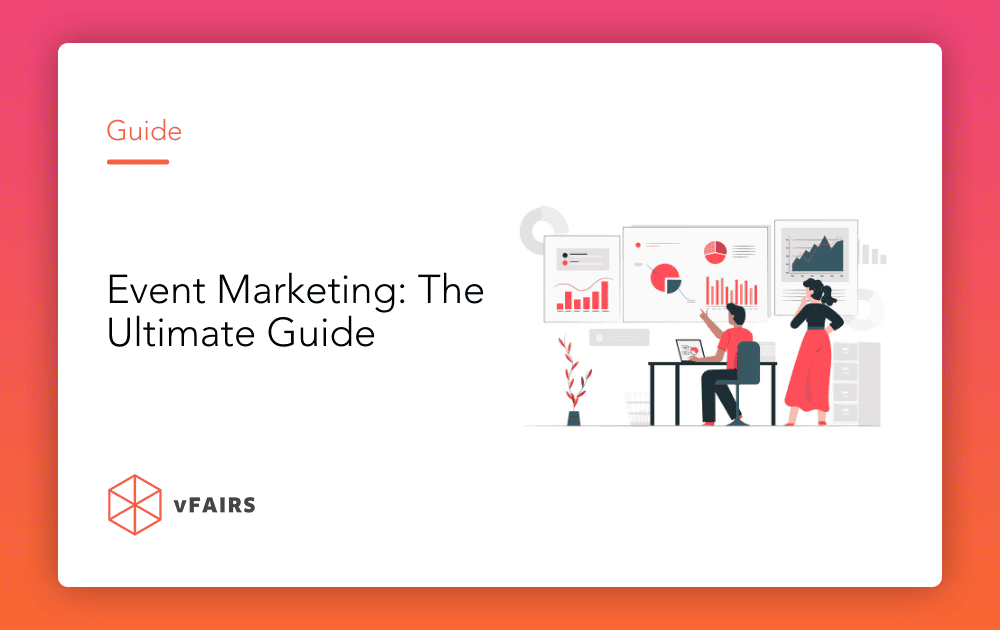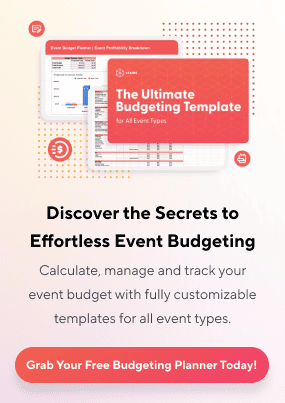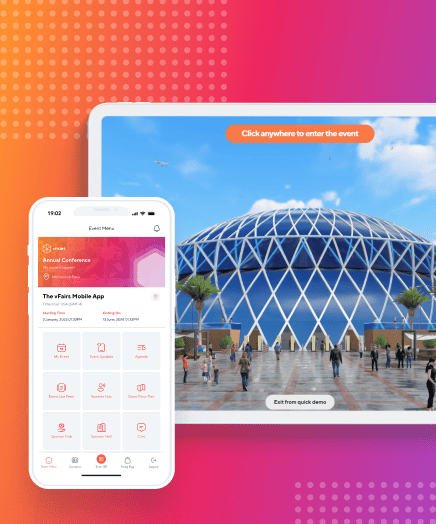Chapter 1: Event Marketing Fundamentals
What is Event Marketing?
Event marketing is a form of advertising in which your company promotes itself by participating in or hosting an event. These events can spotlight your brand’s products or services, whether you take on the role of the organizer, participant, or sponsor. The nature of these events can vary, encompassing in-person, online, or hybrid formats.
The spectrum of events your brand can host is extensive, ranging from marketing conferences, trade shows, co-sponsored or standalone events, to celebratory gatherings and product launch galas. If you operate in the marketing technology sector, you have the flexibility to host virtual, hybrid, or physical events, tailored to your specific niche and requirements.
The key question to ponder is the depth of knowledge you aim to convey to your audience. How to market an event? Are you looking to incentivize attendees to purchase your company’s products? Or would you rather creatively narrate your brand’s story? When executed effectively, event marketing has the power to inspire, educate, offer support, instill confidence, and evoke a variety of emotions in your customers.
Importance of Event Marketing
In the world of event marketing, having a clear event marketing definition is fundamental to success. Remember that marketing an event involves establishing a connection between attendees and brands, and it is a complex mix of out of the box planning, brand positioning and strategy, which is why organizations often onboard a creative digital marketing agency with expertise in this domain to make their events a success. While digital marketing currently dominates the landscape, event marketing still plays a significant role within it. Events offer a valuable opportunity for marketers to build relationships and foster trust with potential customers by providing a more personal touch compared to digital media. They allow customers to engage with businesses on a personal level and gain insights into their distinctive brand personality.
Event marketing provides events marketing managers with various avenues that they can customize to meet their unique needs. It offers the opportunity to strengthen connections with both customers and prospects. For example, if you’re participating as an exhibitor at a trade show, it enables you to educate potential customers about your company’s offerings. Furthermore, you can effectively employ digital formats such as webinars or live-streamed workshops in event marketing.
Event Marketing Benefits
Virtual Events
Virtual events offer a multitude of advantages for event marketers, organizers, and attendees alike. Marketers can tap into a wider global audience, reduce logistical costs, and gain valuable data insights for future campaigns.
Organizers benefit from streamlined event planning, the ability to pivot quickly in response to changing circumstances, and the potential for increased sponsorships and revenue streams. Attendees enjoy the convenience of attending from anywhere, reduced travel expenses, and access to a diverse array of content.
Hybrid Events
Event marketers, organizers and attendees can benefit from hybrid events in several ways. For marketers, they provide extended reach and engagement opportunities by combining in-person and virtual elements, enabling them to connect with a wider and more diverse audience.
Organizers can harness the flexibility of hybrid events to cater to varying preferences, extend event lifespans, and enhance event monetization through hybrid sponsorship models. Meanwhile, attendees gain the flexibility to choose between physical and virtual attendance, allowing them to tailor their event experience to their needs, schedules, and comfort levels.
In-person Events
Event marketing thrives on the value that in-person events offer to marketers, organizers, and attendees alike. For marketers, these events provide a tangible platform to engage with their target audience, create memorable brand experiences, and forge meaningful connections.
Organizers can leverage in-person events to showcase their expertise in event planning and execution, enhancing their reputation in the industry. Meanwhile, attendees gain the opportunity to network, learn, and immerse themselves in a dynamic environment, all of which contribute to a more enriching event experience. When it comes to creating impactful marketing materials for events, in-person events offer an unparalleled opportunity to make a lasting impression.
Chapter 2: Event Marketing KPIs
Registrations & Check-Ins
Using this metric, you can see how many people attended the event. This is helpful as it is critical to compare the number of people who checked in to the event with the total number of people who registered.
Revenue & Cost to Revenue Ratio
You can’t use gross revenue as a useful metric unless you compare it to the total cost of the event. To better prepare for future events, you can use this ratio to see how much profit (or loss) your event has generated and how you can continue to improve it. Sponsors and investors would be interested in seeing this KPI.
Attendee Satisfaction
In event marketing management, attendee satisfaction is a key determinant of whether an event is a success or a failure. Attendees who are happy with their experience will have a more positive view of your company and will pick up a few useful tips. This can help your company’s image and possibly lead to more positive word-of-mouth publicity.
You can also tell if a meeting or event was worthwhile by using polls and other methods of gathering feedback from attendees. Check out the social media buzz surrounding the event. Use web-based software to monitor and analyze the comments.
Chapter 3: Event Marketing Plan
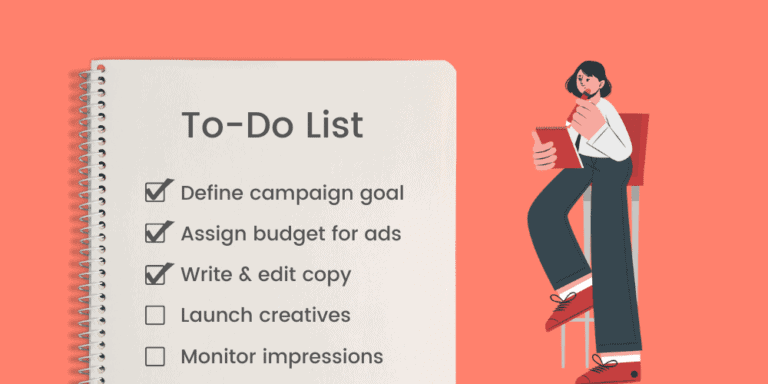
Events naturally have a lot of moving parts that require multiple collaborators to execute. That’s why it’s important to create a plan that includes all of your taskwork, who is in charge of the task, its due date and any other notes and roadblocks. Let’s look at some of the things an event marketing plan covers and how you can make one for your next event.
1. Define Your Event Goals
Before you start planning the event, you should know why you’re planning it in the first place. Clear event goals are the first step to making an event successful because they help hosts:
- Get the event message to the right people.
- Plan activities that will move them down the right conversion funnel.
- Raise awareness of your brand.
Along with this, you’ll need to figure out things like the event name, date and target audience.
2. Identify Your Audience
Comprehend your audience and be clear about who you are targeting and why. The more precisely you can define the target persona you intend to serve, the more successful your event marketing campaign will be.
What should you learn about them?
- Their demographics (age, location, profession, etc.)
- Where they spend their online time
- Their motivations and goals
For instance, if you are hosting a virtual trade show, envision the characteristics of an ideal buyer and their reasons for choosing your offering. You likely possess some knowledge about your buyers already. Utilize your CRM tool to grasp details like their job titles, their primary areas of interest in your products and services, and the initial source that led them to your brand. Did they click on a paid ad or discover you organically?
Take this a step further by analyzing tools like Google Analytics and Search Console. These resources provide valuable insights into the search terms people use when seeking your brand. Once you gain insights into your audience’s conversations and roles, analyze the specific channels they frequently use and the hashtags they engage with. This information is crucial as it will guide your choice of target channels and the messaging you need to employ.
Once you have a clear understanding of your target audience, you must define the desired outcome you expect from them. Establish an objective that you want your audience to achieve, such as completing a registration form. This allows you to measure what success looks like and ensures your marketing messages effectively guide your target audience toward your ultimate goal.
3. Plan the Event’s Budget
Failing to begin with a budget for your event causes costs to escalate rapidly. You’ll be caught off guard by the final tally. A starting budget establishes and maintains realism right from the outset and constitutes a crucial component of an event checklist, preventing you from delving too deeply into budget issues.

4. Finalize Event Partners
Next up, get your event partner in order. A good event planner should keep track of all the speakers, sponsors, exhibitors, and representatives. You probably won’t see them before the event, so making plans ahead of time is essential. The ideal way is to connect with them and confirm their availability 5-7 weeks before the event.
5. Set an Agenda
With the help of your partners, start making plans for the event. Do this before setting up your event so you’ll know exactly what activities you’ll be hosting.
For each line on your event agenda, you need to list the activities that will happen. This includes the list of the activity, the name and credentials (if any) of the speaker, and the date and time the session will start.
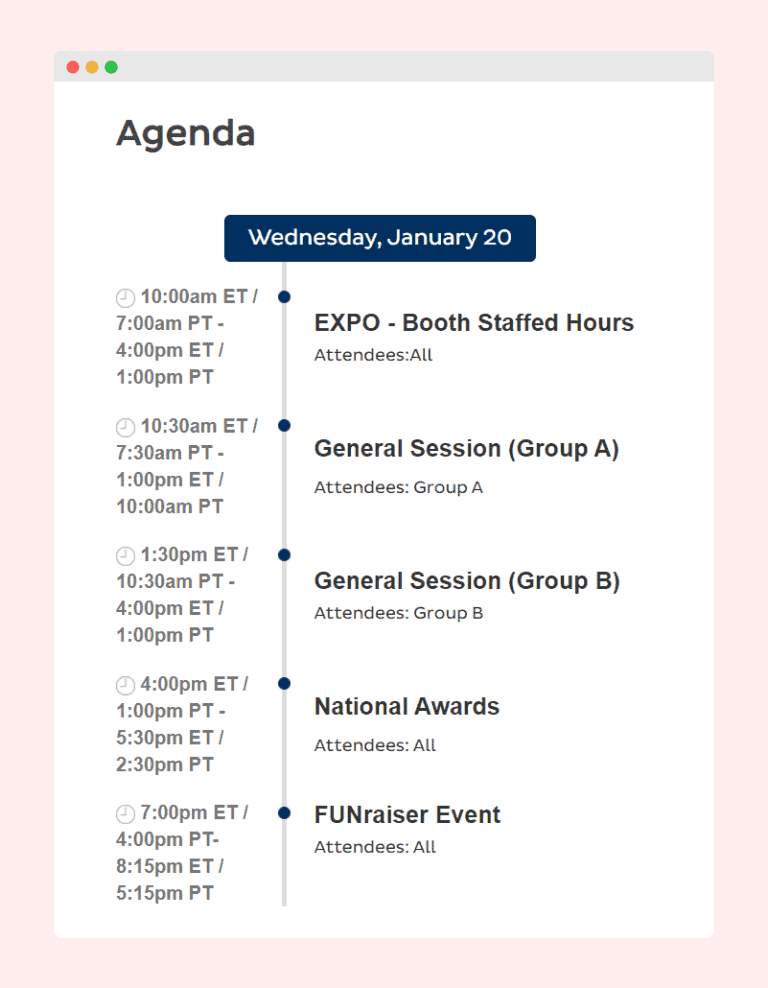
6. Set Up the Event Platform
Now that you have made most of the plans for the event, it’s time to set up the event itself. Setting up an event takes a lot of work. Being an event planner, you have to make the graphics, set up webinars, brand the platform, and do a lot of other things. This is why you should use an event checklist to keep track of as many tasks as you need and cross them off as you finish them.
7. Create a Landing Page
After you’ve identified your audience and the goals you wish to achieve, you need to work on the focal point of your marketing campaign – your landing page. The landing page of the event serves two purposes:
- It helps you freely communicate why people should care about this virtual event (think of it as an elevator pitch)
- It encourages people to click through to your registration page, and sign up for your event
Ideally, your event provider should assist you in implementing the page and enhancing it with an engaging design. Nevertheless, it’s essential to collaborate with them and take ownership of the message, guiding them regarding the specific content elements to be incorporated. Ultimately, it’s your event, and no one comprehends your business as deeply as you do. Ensure that your voice shines through on the page. Apart from “wearing” your brand, the event’s landing page should ideally have the following components:
- A compelling headline
- Date & time of the event
- Event agenda (e.g. schedule of webinars, etc.)
- A brief overview of the virtual event so audiences know what to expect
- Who is exhibiting at the event and who the sponsors are
- FAQs
- Content & imagery that supports your message
- An engaging promo video to attract and convert traffic to registrations
8. Promote Your Event
After establishing the landing page, the next crucial step is to promote it effectively. The success of any event relies heavily on its marketing strategy, so within your event planner, it’s essential to document every promotional channel and its corresponding outcomes.
Begin by determining the means through which you intend to publicize your event. Subsequently, assign ownership for each promotional element, set specific deadlines, and maintain meticulous records of progress. To assist you, here’s an event marketing template to kickstart the creation of your event’s comprehensive marketing plan.
9. Market at the Right Time
Now, you’re all prepared and enthusiastic to announce your upcoming event, ready to start driving traffic to your landing page and boosting registration numbers. However, before you dive in, consider the crucial aspect of timing in your marketing strategy.
Launching your marketing efforts too early may risk losing your audience’s attention, particularly in a digital landscape filled with distractions. Conversely, delaying your marketing campaign could limit your reach and impact. Ideally, you should start setting up your event’s landing page 2-3 weeks before the scheduled event date. This time frame ensures that your event gains visibility on your potential participants’ radars.
Keep in mind that exceptions to this rule exist. For instance, if you’re targeting a niche audience that requires more time and effort to nurture and convert, starting your marketing efforts a bit earlier may be necessary. For example, a virtual networking event aimed at C-level executives in the trucking industry demands a longer and more focused marketing strategy compared to a broad virtual career fair for a well-established company.
10. Leverage Your Existing Audience
Promote on Your Site
Utilizing your website as a platform to promote your upcoming event is a highly effective means of engaging your visitors. We strongly recommend incorporating a prominent section on your homepage, directly linking to your event’s landing page.
You may also explore more sophisticated implementations such as interstitials, strategically placed banner ads, or non-intrusive message panels fixed to the top or bottom of the page. However, it’s essential to strike a balance, ensuring that your promotional efforts don’t become overly intrusive and annoy your site visitors.
Equally important is the content of your advertisements. Craft an eye-catching headline that clearly communicates the benefits for potential participants and instills a sense of urgency to encourage immediate action. Instead of a bland statement like, “Sign up for our virtual career fair next weekend,” consider an approach like, “Connect with recruiters and staff eager to hire!” Additionally, if you already have live chat support on your website, utilize pop-up messages to promote your event and address any inquiries.
Use Email Marketing
Email marketing is a core component of any event marketing strategy. In fact, one study shows businesses make $44 on every dollar spent on email marketing. If you have a subscription base, lead list in a CRM, or any database of potential participants, then you already have a low-hanging fruit to focus on.
However, you still need to craft your email campaign carefully. Think about:
- Target recipients
- Number of emails to send and delays between each email
- A compelling subject line
- The body text
- The call-to-action
For optimal results, concentrate your campaign efforts on individuals you genuinely intend to invite to your event. If you possess additional data about your subscribers, use it to refine and narrow down your email lists for more precise targeting. Strategize the creation of 2-3 pre-event emails aimed at inviting, informing, and gently reminding your target audiences, being mindful not to inundate them with excessive communication.
Encourage Sharing
Once a visitor has committed to your event by signing up, it’s essential to explore ways to encourage them to become advocates on your behalf. This approach offers two significant advantages:
- Leveraging Social Recommendations: People tend to respond more positively to recommendations from their social contacts rather than from commercial entities.
- Cost-Effective Promotion: This form of promotion incurs little to no additional cost.
The optimal time to make this request is immediately after the visitor has signed up. For instance, once they’ve registered on your landing page, you can present a thank-you page equipped with social buttons that allow them to share their participation in your event.
Alternatively, you can send them a confirmation email with an embedded CTA, encouraging them to share the event with their contacts. You can also create visually appealing posts or short video previews that include a CTA, urging audiences to share the message extensively. This can help generate likes, comments, and broaden your event’s reach.
Leverage Your Sponsors
If you’ve successfully secured sponsors for your event, it’s a valuable opportunity to collaborate with them to amplify your marketing endeavors. It’s worth noting that it’s also in their best interest that the event draws in relevant audiences, aligning with their sponsorship objectives.
Here’s how you can harness this collaboration:
- Leverage Sponsor Platforms: Encourage your sponsors to actively promote the event on their platforms, including their website and social media channels. This expands the reach of your marketing efforts to their existing audience.
- Utilize Email and Content: Engage sponsors to send event-related emails to their subscriber lists or even contribute guest posts to their blogs (with their permission). This enables you to tap into their established networks and further promote the event.
However, it’s crucial to work closely with sponsors to ensure the messaging aligns with your overall strategy. Effective marketing material and copy that they promote can significantly enhance the outcomes of your collaborative efforts.
Involve your Speakers
Leveraging your event speakers as event ambassadors is one of the best marketing ideas for events. The key to effective marketing lies in seizing every opportunity to promote your event, whether it’s online, through word of mouth, or via any other channel.
This is precisely why integrating your special guest speakers into your event strategy is invaluable. Ambassadors and spokespersons often serve as the central draw of your event, captivating audiences who seek to engage, connect, and gain knowledge from them. Consequently, it’s entirely logical for them to contribute to the ongoing discourse surrounding your event.
11. Reach Net New Audiences
Create Content
For successful event promotion, prioritize education before asking. Here are a few strategies to keep in mind:
- Use guest posts on relevant blogs to attract visitors.
- Find high-traffic blogs, adhere to their guidelines, and provide valuable articles.
- Collaborate for mutual benefit: you contribute content, they promote your event.
- Optimize with keywords and backlinks for cost-effective conversions.
Create a Series of Teaser Videos
Engaging prospects successfully often involves video content. Create anticipation with event teaser videos. Start with short hints for a big reveal at the campaign’s outset. Gradually release more details, announce the event, and maintain anticipation through stage-specific short videos.
Additionally, consider speaker interviews, where they discuss session content and provide insights to captivate viewers. Showcase venue glimpses and past event footage, if available, to help newcomers envision what’s in store.
Use Pop-ups Across Your Site
It’s also important to market to prospects that are landing on other pages on your website. Use pop-ups to make sure that new and returning visitors to your site learn about the event. You can also use a sticky bar at the top of your page with a CTA that takes users to the event landing page.
You can also sign up your prospects directly from the sticky bar if you add a form field to it. This helps speed up the process and makes it easier for people to sign up within seconds.
Issue a Press Release
For events that are primarily B2B in nature, a timely press release can be an effective way to get the word out quickly. When composing your press release, remember to work on effective messaging. Depict the value proposition of the event, cite who the intended audience is, mention the date and time of the event, and highlight any sponsors/speakers worth mentioning. Of course, don’t forget to link the write-up directly to your landing page so that you can drive referral traffic.
Own a Twitter Hashtag
Creating a unique hashtag for Twitter momentum is one of the top marketing ideas for events. Businesses have long used Twitter to showcase events, products, and campaigns, making it essential for event marketers to join the hashtag movement for visibility.
Hashtags, keywords, or catchy phrases foster event-focused conversations. When users spot your hashtag, it sparks extended promotional reach. Engage sponsors and speakers for wider impact. Generating buzz around your hashtag and linking to your landing page can boost conversions effectively.
Use Social Media
Keep your follower base informed and engaged by regularly sharing updates about your upcoming event, a strategy employed in many successful event promotion examples. To amplify your social media presence, contemplate investing in paid promotion for broader reach and impact. These platforms also offer the advantage of remarketing, allowing you to re-engage users who have previously visited your website or are part of your email list, thus boosting conversions in line with effective event promotion practices.
LinkedIn, Facebook, and Instagram remarketing employ web technology to track visitors who didn’t take action on your event page. Utilizing insight tags on your website or event landing page, they display ads to these same users, ensuring your investment is targeted and valuable for your business.
Opt for Paid Search
Utilize Google Ads as a rapid method to promote your event using strategic keywords. If you’re aiming for swift improvements in event registration, paid advertising for increased online traffic is a crucial initial step. Here’s what you can do:
- Create precise campaigns targeting your defined audiences, regions, and demographics to boost event visibility.
- Craft compelling, action-driven ads to stand out from competitors, driving traffic and registrations while easily measuring their effectiveness.
- Leverage analytics for insights on ad performance and continually improve your strategy.
- Invest in websites and ad formats consistently driving the most traffic to your event’s registration page.
12. Analyze the Event
Tracking how well an event did helps reach four goals:
- Understand exactly who you want to reach and what they like.
- Depict where you can improve.
- Check the return on investment and how well the event went.
- Improve future events
Because of this, it’s important to keep an eye on how engaged the audience is during and after the event. For your event planner, keep track of all the relevant metrics along with your intended outcome and the actual result. This will help you figure out what worked and what didn’t, which will make planning for the future easier. Here’s a free event planner deck by vFairs to plan your next event seamlessly!
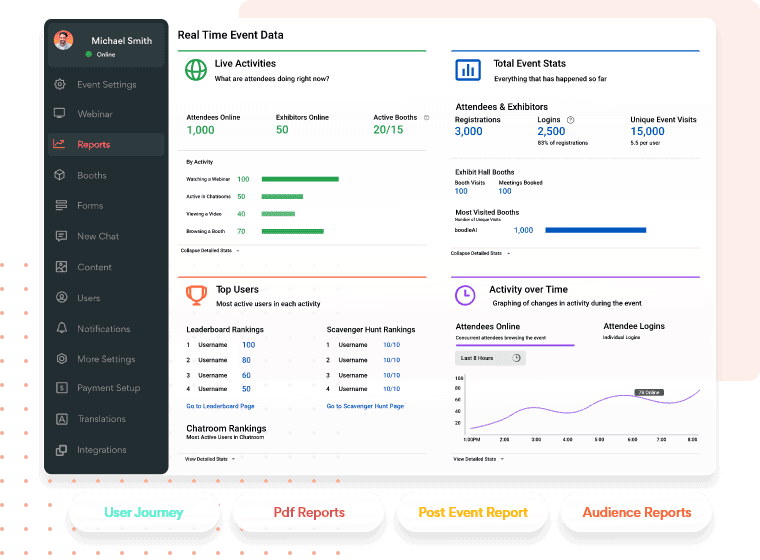
Chapter 4: Event Marketing Features
While the ‘fun’ and ‘games’ aspects of events certainly add value, there’s much more beneath the surface. Beyond enhancing entertainment and attendee experiences, these features can be harnessed as powerful tools to advance your event marketing goals. Discover how vFairs, as your trusted event marketing service partner, can help your organization achieve these objectives effectively.
When you plan your virtual event, you must ensure the virtual space is interesting enough to attract as many people as possible. This can also help you increase your brand visibility and help you conduct better marketing. You can do this if you have a lively environment and designs that grab people’s attention.
Virtual Environment
A virtual setting also makes it easier for people to join the event and get more out of it. This makes people more interested to sign up. People who don’t know much about technology can use the virtual environment features to figure out how to get around your event and where to go for help. Some of these features are:
- 3D designs with animation
- Customized venues
- Immersive rooms
- Branded booths
- Animated avatars
- A live desk for help and information
vFairs is a game-changer in the industry because it makes the whole virtual event experience much more immersive and real.
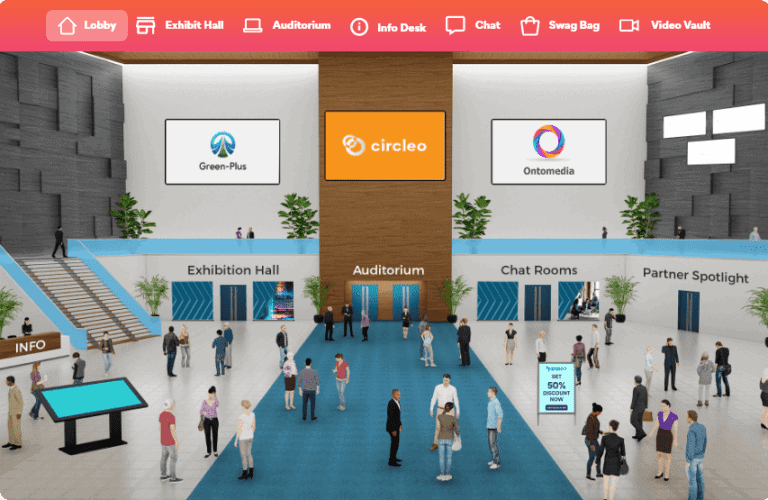
Webinars
vFairs provides a range of webinar features to elevate your event marketing, including:
- Realistic 3D designs for immersive experiences
- Flexible presentation options
- Multilingual sessions for a global audience
- Tailored webinar schedules for attendees
- Interactive Q&A sessions for visitor engagement
- Fun and engaging polls, trivia, and quizzes for gamification.
These webinar features enhance event marketing by creating more engaging, personalized, and interactive virtual events that reach a broader audience and provide valuable data for improving future events.
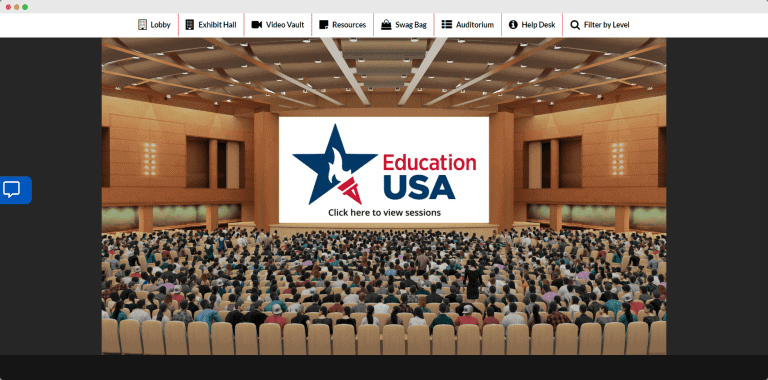
Exhibit Halls
A simple exhibit hall and set-up process will also attract more potential exhibitors, which will help event hosts make more revenue from their events. vFairs custom-made exhibition halls have:
- Branded exhibit booths for marketing
- The ability to store an unlimited number of files and resources
- Self-select avatars for an engaging experience
- Live chat options for two-way communication
- Schedulers and booking systems for future meetings and interviews

Downloadable Resources
Downloadable documents, videos and other resources are also a big benefit while marketing an event. You can dedicate some resources to promoting your event as it’s happening. Attendees can also learn something new about what’s offered, and those who didn’t register will wish to know about what they’re missing.
Mobile Apps
Modern in-person event marketing relies heavily on technology, and interactive mobile apps have become a staple feature. These apps provide attendees with event schedules, session details, maps, and real-time updates. Event organizers can send push notifications to keep attendees informed and engaged throughout the event. You can also integrate interactive features such as polls, surveys, and live Q&A sessions into the app to foster engagement and interaction among attendees and presenters.
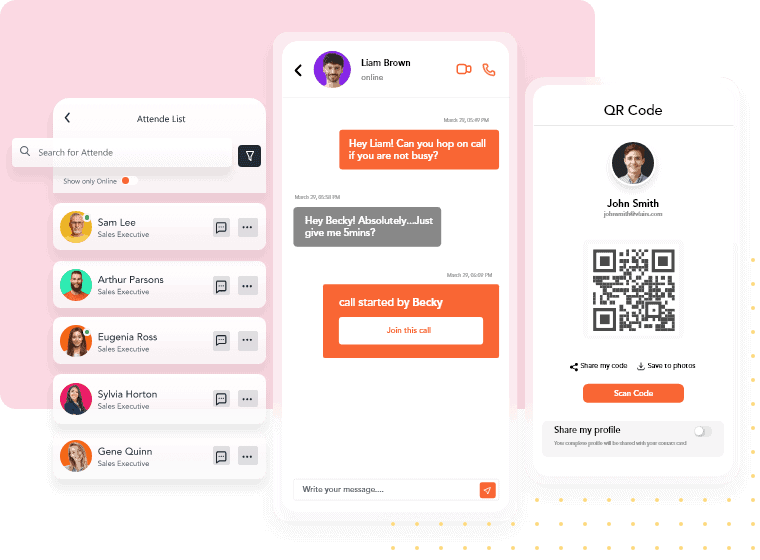
Event Sponsorships
Most of the time, you’ll need to get sponsors to join your event. In exchange, these sponsors will get as much attention as possible, fill their pipeline, and get leads. You can meet these needs by adding features like:
- Customizable designs for exhibit booths
- Visibility of the brand on the landing page and all over the venue
- Gamification, especially for paid games
- Special webinars paid for by sponsors to show off sponsors
- Live statistics for the sponsors to look at and full reports after the event.
For the best results, you can use these features as a pitch to possible sponsors. This will help you get the sponsors you want, and you can even offer tiered packages that give different levels of exposure to sponsors depending on which package they choose. This will help your event bring in more revenue.
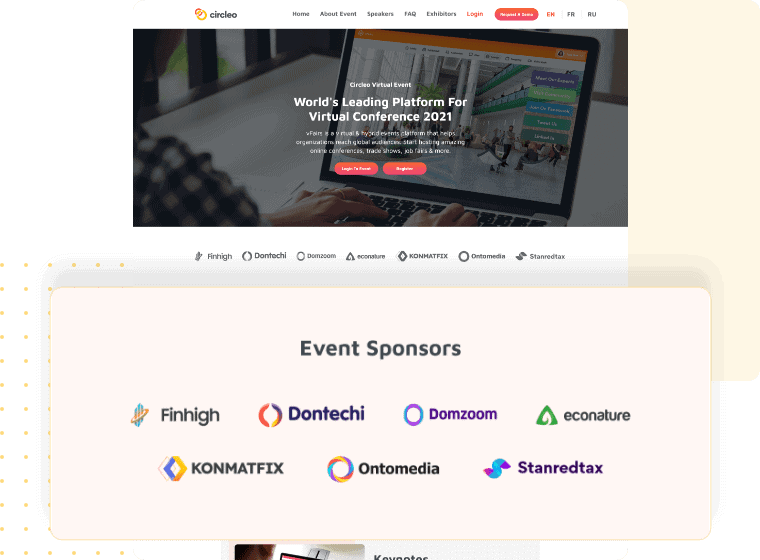
AI Assistant
In today’s digital age, traditional marketing strategies often fall short of meeting the demands for personalization and data-driven decision-making. This is where the AI Event Marketing Assistant comes to the forefront, presenting a groundbreaking solution that revolutionizes event promotion, audience engagement, and attendance.
Chapter 5: Event Marketing Roles
Event Coordinator
An event marketing company is responsible for various activities, including promotions, collateral materials, and media-related tasks. Within this role, an event coordinator organizes, creates, and oversees the implementation of these marketing initiatives. Additionally, part of their duties involves producing media and public relations materials to effectively convey the company’s message to the audience.
They will also oversee and coordinate conferences, seminars, and meetings. They will plan the event marketing calendar to ensure that the program completes on time and participate in managing and developing the program’s budget and resources.
Content Marketing Specialist
While marketing an event, digital campaigns rely heavily on the work of content marketing specialists. They do so by ensuring that the campaign’s objectives are being met. They may also be a part of a broader plan for content marketing.
Any marketing team would be lost without them. So, finding a content marketing specialist with a knack for writing stellar blog posts, articles, and social media pieces is critical because not everyone is cut out for or likes writing content.
Social Media Manager
Social media management may appear simple, but the reality is quite different. Managing multiple social media accounts while successfully implementing the brand’s strategy is a task that only a professional can perform. A social media manager facilitates ongoing communication with existing customers and finds new ways to attract new ones through targeted customer-relations initiatives.
Managers responsible for social media event marketing use platforms such as Facebook, Instagram, LinkedIn, and Twitter to expand a business’s online presence and interaction. They can also use different types of event marketing content to engage audiences through social media. Finally, they also keep an eye on and measure responses to better understand which parts of the strategy work and which don’t.
Chapter 6: Event Promotions Fundamentals
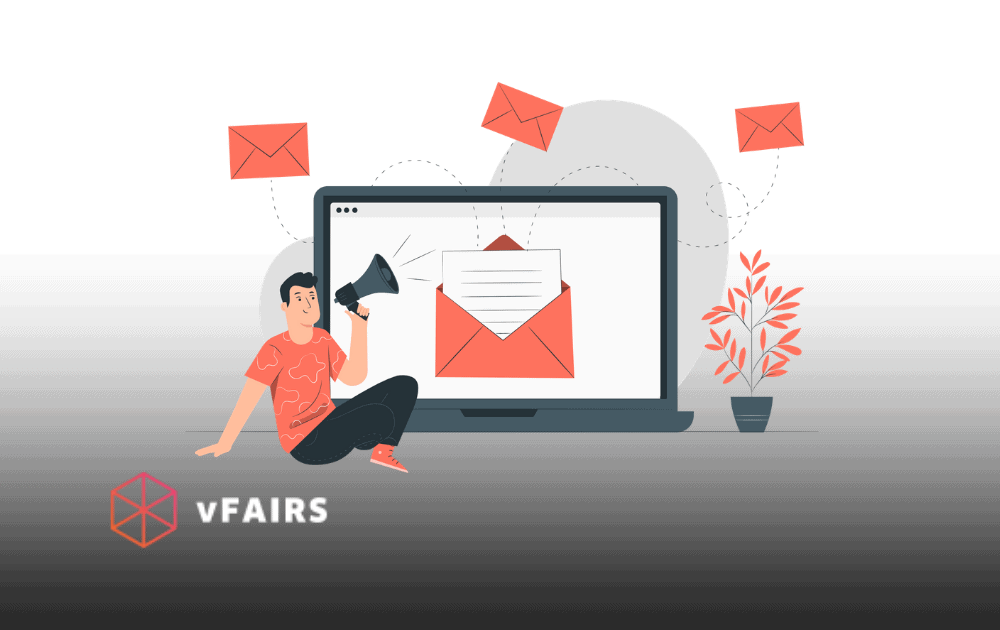
What are Event Promotions?
Event promotion is the process of using various marketing methods and channels to increase awareness about an event and, ultimately, the number of people that sign up to attend that event. This can include print methods and digital channels like email or social media.
Event Promotions vs. Event Marketing
Event promotion is the process of using different marketing channels to get more people to know about an event. A well-publicized event makes more people aware of the organization. This is one of the most important reasons why special events matter. Getting to a certain number of people is not only good for the ambiance of the event, but it is often a key factor in how much money the event makes.
Event marketing involves giving the event, product, or service a brand name and coming up with well-thought-out ways to spread the word about the brand and the event. Event marketing also includes the activities to do during the event to promote the company, product, or service. It uses both inbound and outbound marketing techniques to bring in leads, get people to come to the event, and turn prospects into new customers.
Benefits of Event Promotions
Promoting an event is important for several reasons. The main goal of promotion is to get people to come to an event as participants, spectators, or both. For example, a football game without a crowd is always disappointing.
However, promotion is important to the organization for more than just getting people to come to the event. A well-publicized event makes more people aware of the organization. If there is a sponsor, promotion is important to them as well. The goal of the sponsor is to get as much attention as possible for their name and logo etc. So, sponsors are very interested in promoting the event before it happens and promoting it on the day of the event by putting up signs and product displays that everyone can see.
Chapter 7: Event Promotion Channels
Content Marketing
Marketing through content is an excellent way to get your message out there. Using this strategy, you’ll be able to connect with the people you’re attempting to reach in a meaningful way. It also varies from traditional advertising in that it intends to be informative and relevant.
The best place to start with event content marketing is to inform potential attendees about the pertinent aspects of the event. You’ll want to tell them the basics: what, when, and where. You’ll also want to tell them who will be speaking and exhibiting, how much tickets will cost, what the schedule will be, and, most importantly, why they should come.
Let’s take a closer look at some of the things you can write about at an event:
- Pre-event blog postings
- Videos, audio recordings, and podcasts documenting the event
- Promotional interviews and guest posts
- Real-time tweets and other social media updates throughout the event
- Promotion before the event and social media posts by participants to generate interest
- Speakers’ interviews and video clips
- Streaming videos and live webinars
Any event gives you a new chance to get people interested in and excited about your brand. It might help to renew an outdated content strategy. Moreover, you can use AI tools such as ChatGPT to create marketing collateral within minutes and avoid monotonous tasks. Here are some ways event planners are using AI tools for marketing.
vFairs’ AI-powered marketing tools can shorten the event setup and marketing time span for you by creating marketing collateral such as content for landing pages, email copy, social media posts, press releases, and so much more.
Social Media
Making a strategy for event promotion on social media is critical. Before an event, organizers can spend a lot of money and time marketing it, but they may not give much thought to what happens after the event is over. Social media event promotion doesn’t end when your guests leave the venue.
Connecting with your audience before, during, and after an event is an important part of a successful social media event strategy. Using these social media event marketing tips, you can create an unforgettable digital experience for your guests from beginning to end.
Before the Event:
Take Advantage of Instagram Stories by Posting a Countdown
It’s possible to set an end date and time for an Instagram Story using the countdown sticker. You can change the clock’s name and color as well. Subscribers will receive a notification when the clock expires, or they can add the countdown to their own stories and share it with their friends.
Create a Facebook Event Page
Create a Facebook event with all of the pertinent information for your guests. Please be sure to include the official pages of any speakers or guests you’ve invited. In the event discussion area, you can make announcements or respond to questions. Presale codes or show times for a concert could be useful information to spread around the area.
Add Necessary Details to Teaser Posts
In the run-up to the event, provide relevant information. Teasers are a great way to get your audience excited about your event while also providing them with useful information. Give your guests a taste of what they can expect at the event by revealing tidbits well in advance. In addition, they’re a great way to showcase your guests of honor. During the weeks leading up to a large conference, you could also introduce your guest speakers one by one.
Make Use of a Hashtag
You and your attendees will appreciate the ease with which you can find all of the content associated with your event using a custom hashtag you create for the occasion. If you don’t want to bury under mountains of irrelevant content, create a hashtag that is new and unique.
Add Videos
Using videos can be a fantastic way to boost your event marketing efforts and take them up a notch. Your social media content strategy can be incomplete without incorporating videos because they are much more immersive and engaging for all audiences. Start here to find some exciting ways to leverage videos for event marketing.
Organize a Contest
You can increase the number of event attendees and increase the visibility of your brand by holding a social media giveaway contest. Request that people use the hashtag when they share a post from your account about a contest they are entering. You’ll have the attention of their followers as well once they’ve shared your content. For the price of a few free tickets or products, you can reach a much larger audience.
After the Event
Share User-generated Content From the Event
This is why it is important to have a short, easy-to-remember hashtag for your audience and presenters. Your attendees will feel more at ease if you engage with and share the material they’ve created. To celebrate your accomplishments, you’ll also be able to show off your event from a variety of viewpoints.
Follow Up With Customers
Keep in touch with your audience after the show is over and before they head back to their regular routines. Make sure everything is in its proper place. Follow up with people who had unresolved complaints or concerns to ensure that the issues were resolved.
Add Event Highlights to Your Collection of Saved Items
Using Stories allows you to post more content with less concern for its quality since they don’t take up any real estate on your profile. However, if you’ve been covering an event well, you don’t want to lose all of your work in just a day. It’s possible to save content from Instagram and Facebook Stories to your Highlights so that it can be accessible again and again in the future.
Prepare Summaries for Those Who Couldn’t Attend in Person
People who couldn’t make it to the event in person can still participate virtually. Share content that gives people a glimpse of what they may have missed out on. Post photos and videos that make them feel as if they were there.
Analyze Your Data in-depth
Analyze your team’s performance and how well you managed to implement your strategy. You can use the information gleaned from this campaign to improve your social media strategy in the future.
SEO

Several businesses organize various local events. When it comes to planning an event, whether it’s for a business conference or an informal get-together, you want the right people to see it. Here are our top tips you can use to get the most out of SEO:
Segment Your Target Market
Segmenting your target audience is essential before you begin promoting your event. It will be much easier for you to devise an effective event marketing strategy once you have decided who you want to attend the event.
Achieve Specific Objectives by Using the Proper Metrics
Setting SMART (specific, measurable, attainable, relevant, and time-based) objectives is critical in event marketing. These goals will help you stay on track and remind you of the results you want to achieve during your campaign.
Keep a Check on Your Progress Choosing the Correct Instruments
You should document your KPIs ahead of time so that you can monitor the progress of your event as it moves through its various stages. Because of this, you need to have the proper equipment. If you use tools like SEMrush or Ahrefs, you can easily audit your content and check backlinks, shares, rankings, and traffic. You’ll never miss a mention of your brand or important keywords again thanks to Google Alerts.
Create an Optimized Event Page
Google uses your event information to determine your usefulness. Relevant events have recently been rearranged in the SERPs. A callout box at the top of search results now includes these events. This fantastic option increases your visibility. The callout box is the most important way for a searcher to learn about your event’s type, location, date, or time.
Email Marketing
Email promotion is essential for success, whether you’re throwing an annual party or planning your company’s first conference. Email marketing is still one of the most efficient ways to market, so it makes sense to use it to promote an event. The right event email marketing strategy can help you get the right messaging out that is also personalized to a particular audience segment.
Use a Launch Campaign to Get People Interested in Your Event
Event launches may start with emails that tell people what’s coming and when to expect more information, just like product launches. In a simple campaign, you might send out a few emails to get people interested and invite them to the event. A stronger campaign might use media and promotional content to get people excited.
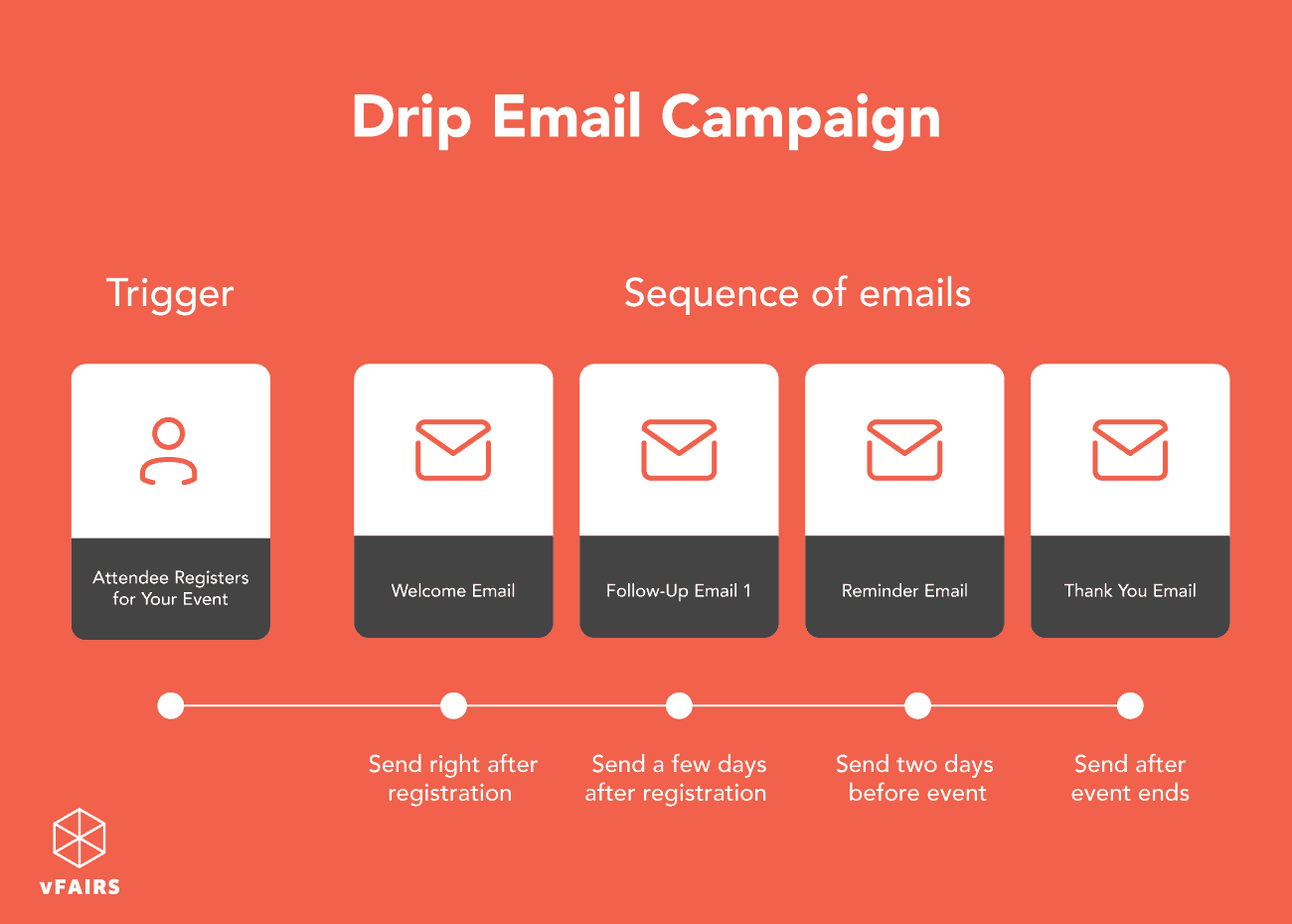
Invite People to Your Event by Giving Them Special Deals
If your pre-launch went well and you want to make the most of your email list, use special deals to get people to sign up for your event. You can give something small, like free promotional items, or you can give your subscribers a discount code with an expiration date to make them feel like they need to act quickly.
Include Interesting Content to Get People to Share Your Event.
Most people don’t think about referrals when they think about events, but the truth is that many events are spread through word of mouth or social media. You can get more people to know about your event through emails that encourage your subscribers to invite their friends and family.
As the Event Date Approaches, Tell People What They Need to Know
You can send two types of emails about details. The first is an email sent to people who purchased event tickets and require additional information. The second email is sent to individuals who have not yet purchased tickets but are curious to know details such as cost and registration. In a successful campaign, multiple of these may be sent.
Don’t Let Important Dates Pass Without Reminding People About Your Event
As the event date gets closer, you want as many people as possible to sign up. That means you need to send reminder emails with a sense of urgency and a call to action that tells people to sign up. This could mean sending a dozen emails the week before a big event.
After an event goes well, you should thank the people who came and the people who helped make the event possible. You can use this time to talk about statistics from the event, or you can just say thanks and say you’ll see people again. People can also give feedback in a “thank you” email.
PPC
Pay-per-click (PPC) advertising is a form of paid marketing that enables you to generate high-quality leads for your business. These advertisements appear at the top of search results, above organic results. You can set numerous objectives for a PPC campaign. The most prevalent objective is to achieve a specific number of conversions or conversion rates. Since PPC ads attract more likely-to-convert leads, many businesses set conversions as their primary objective.
Influencer Marketing
In the world of event marketing management, leveraging influencer marketing has emerged as a powerful strategy to promote brands and productions effectively. Most of the time, people follow influencers who they can relate to and trust. As a result, these followers hold brands and products endorsed by influencers in high regard, making influencers instrumental in driving event promotion websites and event marketing strategies
Sponsored posts on social media appear to be the norm, but businesses are beginning to recognize the value of collaborating with influencers to promote events. You can use the following tips to efficiently use influencer marketing to promote your event:
- Target relevant influencers for your brand
- Develop an influencer strategy
- Encourage them to promote event-pre-hype
- Get them to promote in real-time throughout the event
- Have them publish content after the event
Chapter 8: Event Promotions Plan
In the event marketing timeline, success hinges on effective promotion strategies that captivate audiences, build anticipation, and drive participation. Whether you’re organizing a virtual conference, a product launch gala, or a trade show, a well-structured event promotions plan is your guiding light. Here are the key elements of a promotional plan.
Elevator Pitch
An elevator pitch is a brief, compelling speech used to generate interest in what your organization does at an event. Every business or business concept should have an elevator pitch. This is an excellent marketing exercise for businesses seeking to clarify their values and objectives. This 30-second to 60-second speech unveils a company or a project persuasively and clearly.
The primary purpose of a pitch is to garner interest in a project or concept. Developing an elevator pitch for your event will assist you in conveying your company’s core values and organizing your marketing efforts accordingly.
Personas
Attendee personas are fictional representations of your event’s target audience. An event marketer can use it to comprehend their target audiences. They are called “personas” because they represent individuals within a larger group. By creating attendee personas to represent the various types of individuals who would gain from attending your event, you can discuss your event marketing content so that your readers feel as though you are communicating to them.
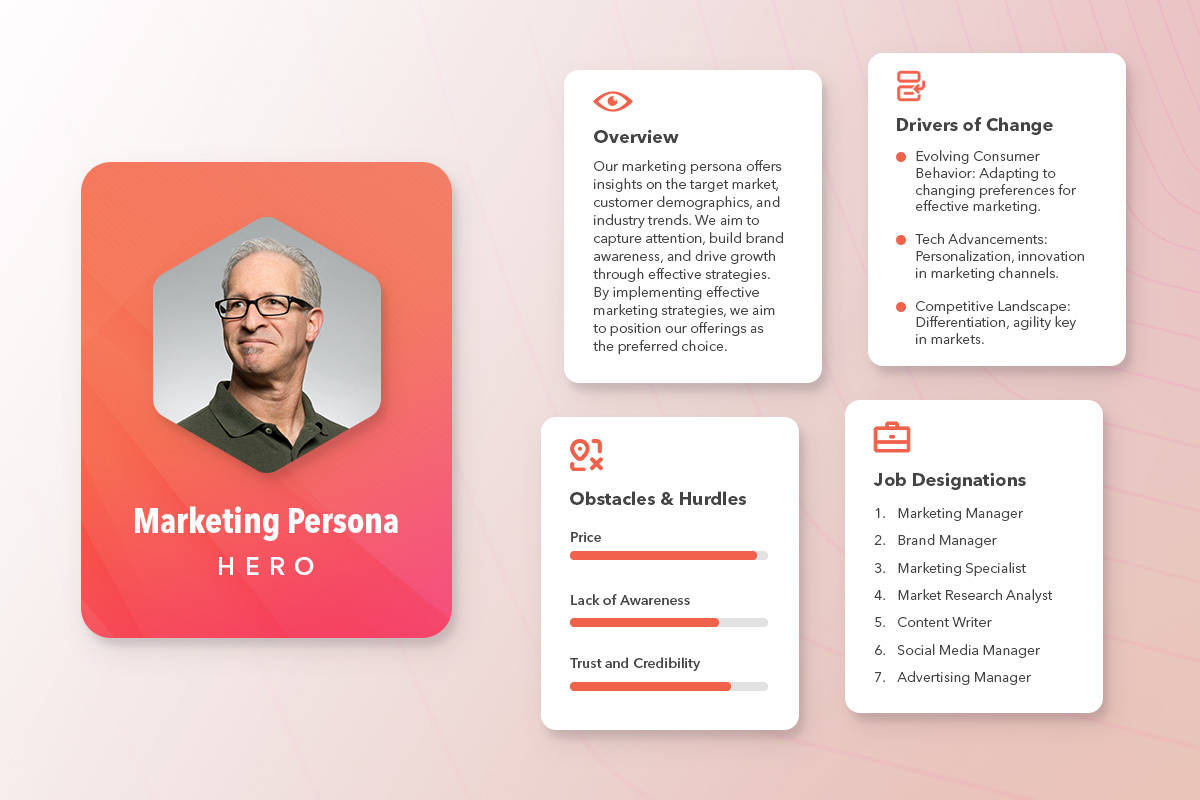
Attendees Journey
The attendee journey is a timeline that outlines every facet of the experience your attendees will encounter before, during, and after your event.
Awareness Stage
Always emphasize the problem that your event will solve for attendees when promoting it. For example, if you’re hosting an event for freelancers, you can say in your event marketing campaign that your company and the speakers will show the attendees how to get more work and close more deals. In the awareness stage, you will express your attendees’ pain, validate it, and reassure them that attending the event will provide them with the answers they seek.
Consideration Stage
At this stage, you have to make sure your client moves forward toward the decision stage. Your buyer personas are the individuals who are willing to purchase the solution that meets their needs. Therefore, a robust brand experience at the event is essential.
These brand experiences can include stimulating your attendees’ senses through experiential marketing and providing an immersive environment through mixed reality, compelling storytelling, etc.
Decision Stage
At this stage, the customer wants to make a purchase. Offer your guests the exclusive opportunity to create powerful business connections at your events to strengthen your standing as an industry connector.
Competitor Research
Conducting competitive research entails locating and identifying your business’s rivals, as well as analyzing the advantages and disadvantages of both the companies themselves and the goods and services they offer. Using competition analysis in the event planning process, you can discover new event opportunities while also considering the inherent risks. Before planning and executing an event, event organizers examine the market and their competitors.
Process Mapping
A process map is a management and planning tool that graphically depicts the workflow. It illustrates who and what is involved in a process, applies to any business or organization, and can reveal improvement opportunities. It is a diagram that details the various phases that make up a process, including who is responsible for each task and how long it can take. They are especially useful for conveying processes to stakeholders and highlighting areas for improvement.
The purpose of process mapping is to improve the effectiveness of organizations and businesses. Process maps provide insight into a process, assist teams in generating ideas for process improvement, enhance communication, and document the process. The mapping of a process will also reveal bottlenecks, repetition, and delays.
Chapter 9: In-Person Event Marketing Strategies
Many event planners see in-person events as a vital part of their entire marketing strategy, and as a result, many more are planning to host them soon. People now think it’s less important to have a big splash with a show-stopping headliner than to give attendees a sense of community and business value.
As with any other marketing, having a strategy allows you to define your approach and take the necessary actions to reach your objectives—before, during, and after the event. Here are a few in-person event marketing strategies to keep in mind.
Manage Your Budget
If you don’t know where your money is going, you’re probably spending more than you should. Tracking your finances is essential for increasing the ROI of your event and managing your total cost.
The initial step is to clarify your event budget strategy. Before budgeting, take a step back and think critically about what you’ll be investing in. Next, you must include all the line items to track in your budgeting template. These will include information such as rental costs and A/V equipment.
You also need to use tools like analyzing event ROI and building an emergency fund if needed. It’s best to create an event budget template that is relevant to your event and will assist you now and in the future. Here’s an all-in-one event budgeting template for all event types that we have created for your ease.
Finalize a Venue
Even before COVID hit the world, the events industry took precautions to ensure that attendees were safe. However, these days venues are doing more to maintain their spaces clean and safe for their guests. For your in-person event, look for a location that prioritizes the attendees’ wellness. Many venues are devising innovative ways to prioritize health and safety, from touchless check-in kiosks and hand sanitizer stations to prepared meals and no-line food service.
Event organizers are increasingly looking to one-of-a-kind venues to host events that stand out from the crowd. Since atypical places offer fewer events than standard spaces, ensure that the space you like can meet your event’s practical requirements, such as capacity or safety measures. Moreover, one of the most significant factors to consider is the venue’s size. Finally, you must estimate how many individuals will attend so that you can choose the venue size accordingly.
Confirm Speakers
For a successful large-scale event, recruiting assistance from speakers, sponsors, and exhibitors is essential to balance costs and bring diverse industry perspectives. Selling speaking slots is a common method to enhance your event’s value. If your event has multiple sessions, sourcing and securing speakers becomes paramount.
Efficient sourcing and outreach strategies optimize your resources and ensure your agenda reaches the right individuals. Crafting a compelling sales pitch is crucial when selling these slots, highlighting the benefits of participation, such as attendance rates, demographics, and buying power. Additionally, define your speaker requirements, emphasizing relevance, influence, and purpose. Evaluate potential speakers, choose top contenders, and consider factors like your event’s needs, storytelling potential, identifying emerging talent, and promoting diversity in your speaker lineup.
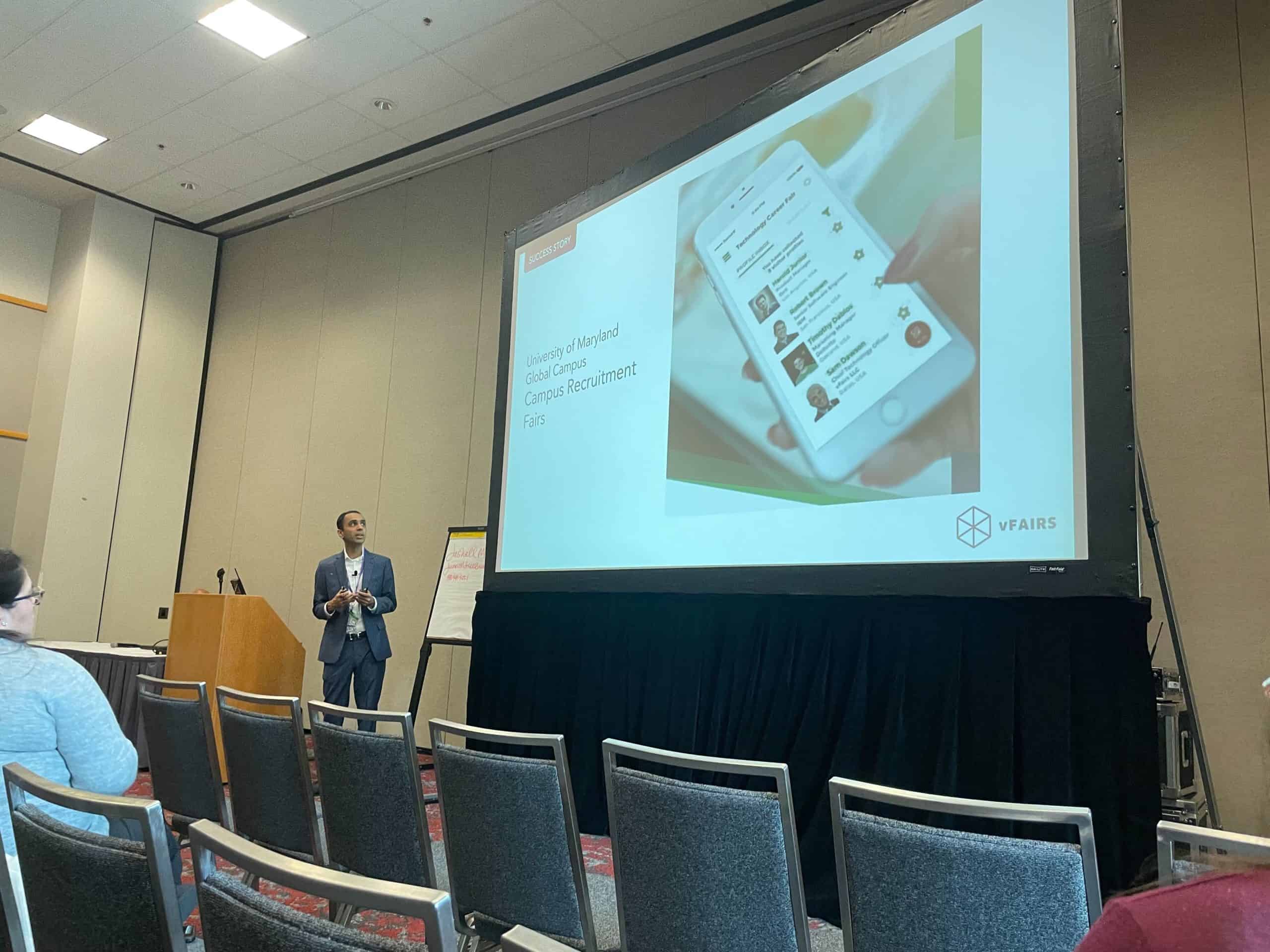
Find Sponsors
Potential sponsors are difficult to identify and even more difficult for many event organizers to convert. Remember that as long as you are contacting firms related to your event, you have something they want: the attention of their target audience.
Consider your attendees’ needs and compile a list of companies that can provide those needs. You’ll find a diverse group of possible sponsors. Those whose audiences are similar to the events and whose businesses would immediately benefit from their involvement are the most likely and best-fitting sponsors.
Now, determine what you can give the sponsors. If your audiences are similar, you may provide them with a complete data report, analytics, and survey findings. Most of your sponsors perceive your event as a chance to promote their own company. They want to see figures indicating that the event will be a success. Your offer may contain a spreadsheet with information about the audience’s age, gender, social media activity, etc. You can offer several tier alternatives. In tiered sponsor packages, there is a list of the possibilities and what you will give at each level.
Create Event Branding
By developing a strong brand across all your communication platforms, you deliver a consistent message about your main components such as who you are, what your event is about, and the value your audience will get by joining.
Your event’s branding sets the tone for the entire experience, from the name and theme to how it looks and feels on-site. You want your event to have a distinct personality that makes it stand out. A strong event brand also provides your event with a purpose and assists you in determining where it should go. Next, consider how consumers will perceive your brand in person. Finally, determine how you will incorporate your event’s brand into all aspects and areas.
Map Out Attendee Journey
In event marketing management, mapping out the attendees’ journey is another excellent way to market an event. This means you need to think about your event regarding attendee touchpoints. For example, when and how will they engage with your event and, by extension, your brand?
Knowing where participants interact with the event before, during, and after it can introduce marketing opportunities you didn’t even know existed. You can think about how an attendee might contact your brand to get started. Where do they begin their journey, and how do they get there? Take note of all steps, from marketing an event and pre-registration to the post-event survey. vFairs lets you map this journey and gives you all the detailed statistics you need.
Develop a Landing Page
More people will spread the word about your event if you have an attractive event landing page. This is where your guests are most likely to tell their friends and followers on social media about your event.
The primary purpose of a landing page is to inform people about your event and invite them to take action by registering. This is the hub of the event marketing plan since it’s where all your promotional campaigns, like emails and social media promotions, etc, will likely lead people to. Therefore, the landing page needs a lot of special attention. You can create a unique landing page for your event marketing. You can also upload promotional videos and speaker bios to get more people to come and get excited.
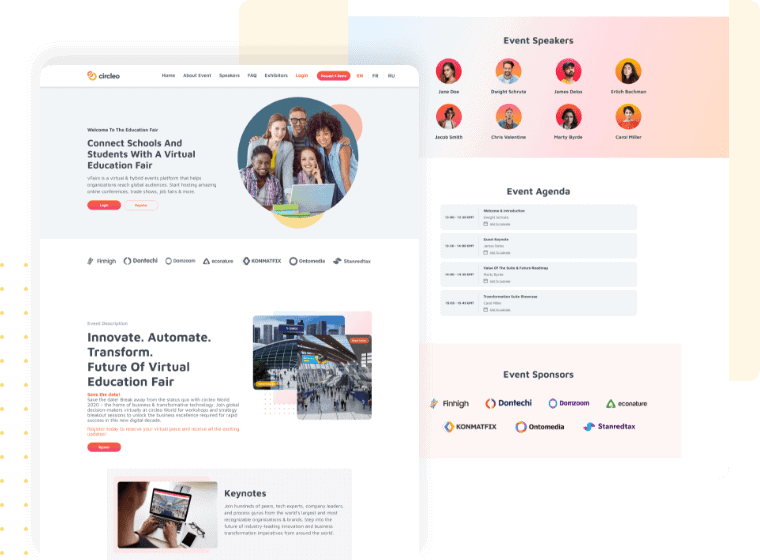
Launch a Campaign
Just like introducing a new product, the launch of a new event may begin with an email informing attendees of what is to come and when to expect further details. You could send a few emails for a primary campaign to generate buzz and invite people to the event. Exciting the public could be the key to a successful campaign, and media and promotional content are two ways you can accomplish this.
You can also consider paid advertising if you need to increase your reach quickly. You can ask participants to promote the event on their socials. An ideal way is to excite the participants by sending a premade GIF or image they can post and tag your account. You can also announce their participation to make things easier for them. They can easily reshare the posts to increase their reach!
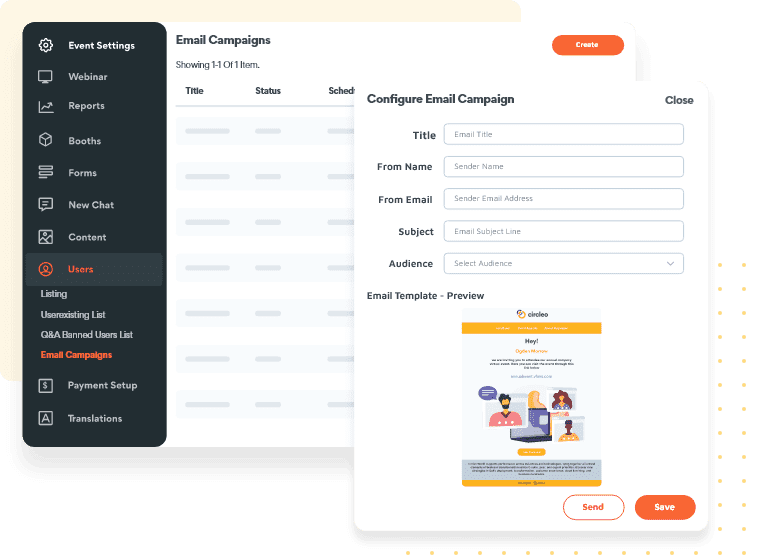
Keep Registrants Interested Through Social Media Marketing
Just because someone has registered doesn’t confirm them to be an attendee. You have to promote the event to keep registrants interested. An ideal way is to use social media. To build excitement, you can offer innovative reveals of lineups or special guests, as well as teaser films and photographs.
You can, for example, submit your own countdowns to the event. Behind-the-scenes photos are also helpful in seeing what happens behind the scenes. Attendees also prefer a photo booth area focusing on small elements that would make wonderful Instagram or Snapchat shots.
Analyze the Event
You’ve spent time and money on an event that’s been in the works for months. Internal stakeholders will want to know if the fruits of their labor were worth it. How did you sell the tickets? How many did you sell? How much did each person pay to attend? How many good prospects did you get? How many orders have been made ahead of time? These are a few of the variables you can check after the event.
You can also track the traffic and activity on your landing page to compare how many visitors you got and from where they came. This will help you understand the entire dynamic of page traffic vs. registrants vs. attendees. Not everyone who visits your page registers, and not everyone who registers attends the event. You can understand how well the landing page helped convert visitors into attendees.
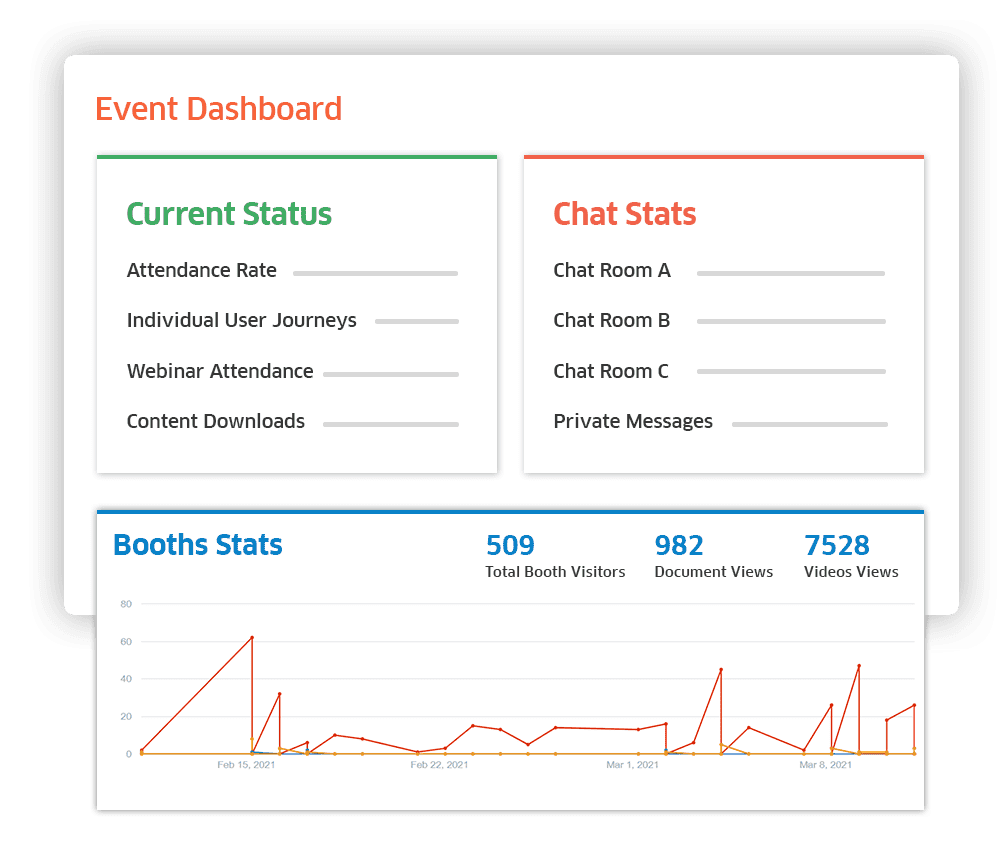
Chapter 10: Event Promotions with vFairs Event Management Platform
vFairs is an all-in-one event management platform that allows you to market your event like a pro. With vFairs, you can create a landing page and send out email campaigns to get people excited about attending your event before it even starts.
vFairs Event Marketing Features
Custom Domain
Having a custom domain is like having your very own section of the internet all to yourself. A custom domain is not a must for visibility in search engine results, but it does help. Most search engines give preference to linking to the root domain rather than a subdomain. Therefore, without a domain name, it’s quite unlikely that any of your content will ever appear in search engine results.
vFairs gives you the ability to host your virtual event on a custom vanity URL, which makes it more memorable and gives it a more customized feel.
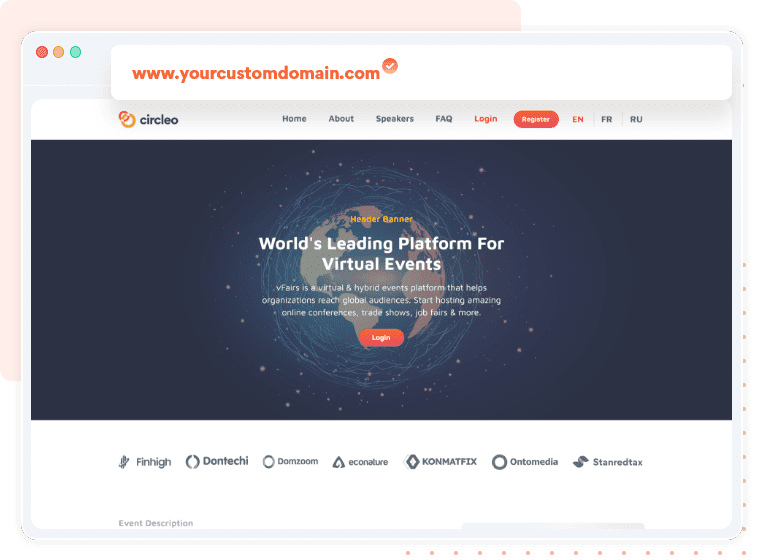
Branded Landing Page
If you have a landing page for your event, you can tap into more “word of mouth” advertising. This is where your attendees are more likely to spread the word about your event to their friends and followers on social media. With vFairs, you can make a landing page for your event promotion that is uniquely yours. You can also upload promotional films and speaker bios to increase attendance and excitement.
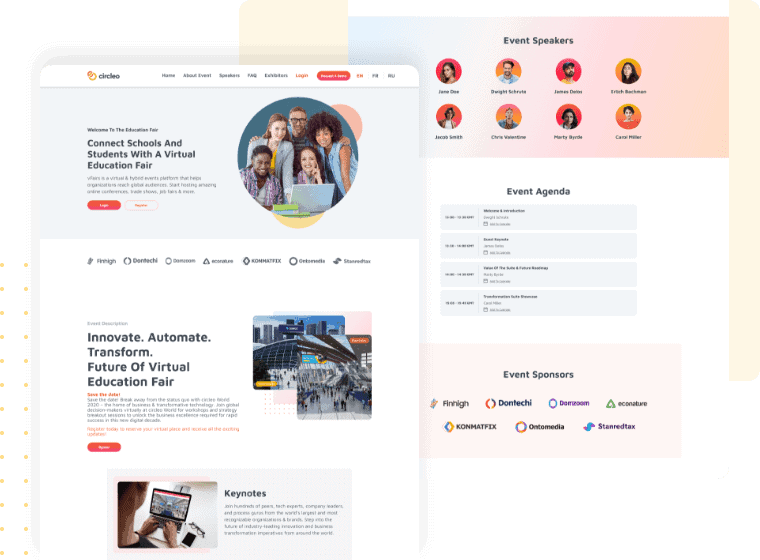
Multilingual Content
As more people across the globe have access to the internet, languages other than English are beginning to gain popularity. When marketing an event with vFairs, you can offer landing pages and information in several languages to reach a wider audience, as well as encourage accessibility and diversity.
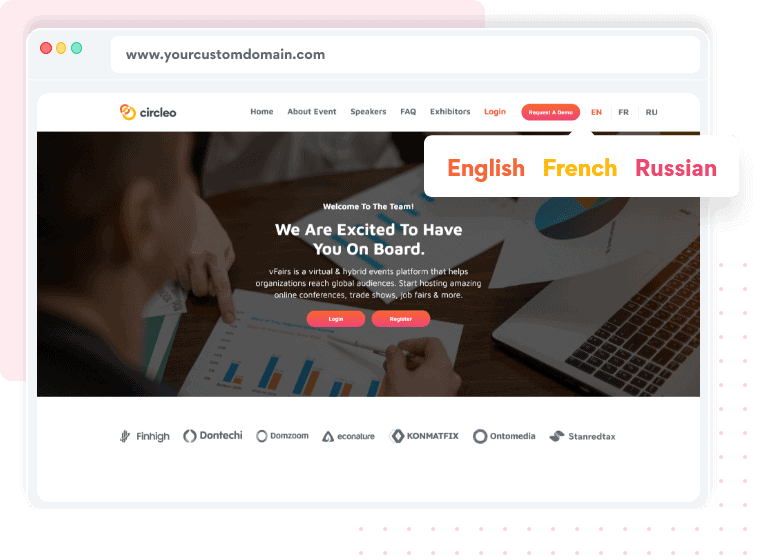
Badges and Lanyards
vFairs provides a valuable tool for enhancing attendee engagement and sponsor recognition through personalized badges and lanyards at in-person events. These badges and lanyards offer a highly visible and tangible canvas where sponsor logos and colors can shine.
When attendees wear these branded badges and lanyards, they essentially become walking billboards, carrying sponsor recognition throughout the event. This level of exposure provides sponsors with a significant and widespread presence, making their branding an integral part of the event’s physical landscape. It’s a direct and effective means of reinforcing sponsor recognition and engagement among attendees, a fundamental aspect of in-person event marketing.
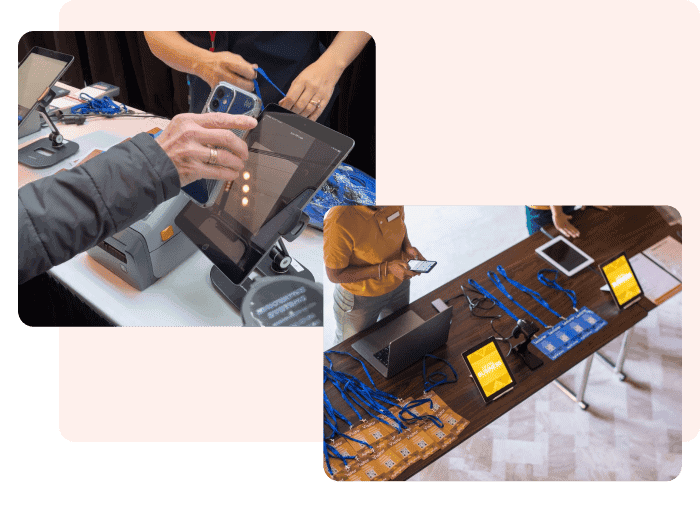
Email Marketing
Using email marketing to promote an event is a great method to reach out to a certain demographic with relevant information and encourage them to sign up for and attend the event. Because of vFairs, you can send out emails that are completely yours. You can also use one of vFairs’ pre-made, action-optimized email templates or the vFairs AI assistant to instantly create your own.
AI Assistant
The vFairs AI Event Marketing Assistant is a versatile and comprehensive tool designed to simplify and elevate event marketing endeavors.
One of its standout features is the ability to effortlessly craft email campaigns. This AI email campaign builder eliminates the need for extensive writing. With just a few selections for email type, tone, and recipient list, coupled with the option to add specific instructions, it generates well-structured event emails.
Additionally, this AI Event Marketing Assistant simplifies creating landing pages and streamlines event promotions, including press releases, video promo scripts, and catchy social media posts. It’s an indispensable companion that empowers you to focus on creating memorable and successful events while it takes care of the intricacies of event marketing in today’s digital landscape.
Interactive Mobile App
The vFairs mobile app stands out as a powerful ally for event organizers looking to enhance their in-person events. With a suite of features designed to create engaging and immersive event experiences, this mobile app takes event marketing to the next level. The vFairs Mobile App offers event organizers the opportunity to create fully branded and white-labeled apps.
Event organizers can create a fully customizable in-app sponsors’ screen, prominently featuring sponsor logos, messaging, and links to their offerings. This dedicated space serves as a high-visibility platform for sponsors, reinforcing their presence and engagement with attendees.
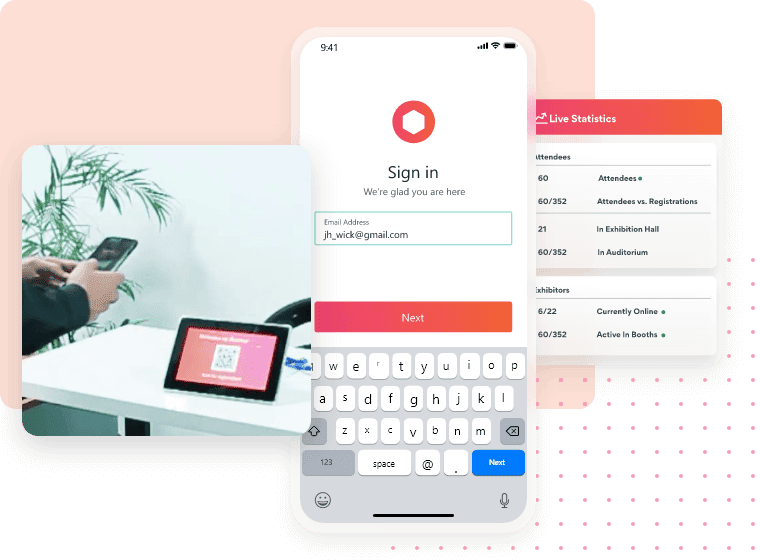
Email Pre-scheduling
Planning is crucial in event marketing. Once the groundwork is complete, however, using pre-event email templates makes automating the tough tasks and reaching the correct people a breeze. When using vFairs, you may set up a schedule for sending emails, complete with triggers and deadlines. As a result, you can streamline the procedure for big campaigns.
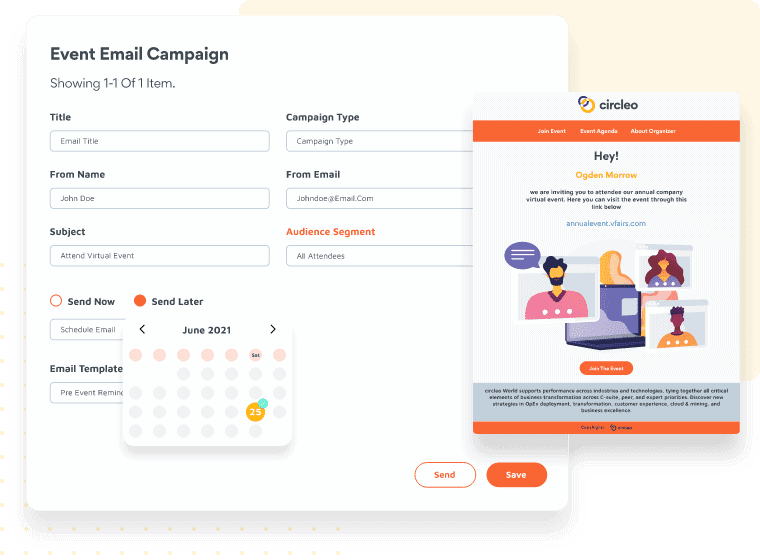
Event Discovery Sites
Make sure that your event features on platforms that allow people to discover events. People visit different sites on purpose to look for activities that are taking place in their area. Whether it be a convention, expo, educational gathering, or commercial event. You have the option of posting your event on vFairs Discover. It is a terrific approach to attract participants to your virtual event if you showcase your events on such platforms.
Chapter 11: Advanced Event Promotion Strategies
Cross Promotion w/ Stakeholders
Cross-promotion is the process of forming strategic partnerships with other businesses to increase brand awareness and sales while lowering advertising costs. This strategy allows you to cross-promote your products and services with those of other businesses. By forming strategic alliances with other brands, you can significantly reduce marketing expenses and enhance your value chain strategy. Before beginning the process, you must conduct industry research and compile a list of all potential partners. Then, consider inventive means by which you can assist them.
Cold Email Outreach
According to a HubSpot study, 33% of cold emails receive a neutral or rather positive response from consumers. The most recent form of outbound marketing, cold email outreach, entails compiling a list of potential clients and then sending a template email to a vast market. It is the large net used to capture B2B customers. When you send a large number of cold outreach emails, you expect a small percentage of recipients to respond. Your sales team is the force that converts these cold outreach campaign responses into paying customers.
Pre-Event Video Shoutouts
Videos have a distinctive ability to reach and engage prospects and customers by appealing to their emotions. If your target audience begins to feel connected to one another, your brand, and the speakers on an even more personal level, registrations are an excellent outcome. Can you think of a more effective content format for fostering such a relationship at scale? A well-thought-out video marketing strategy will not only help you to increase ticket sales, but will also help to ensure a high standard of community excitement before, during, and after your event.
Pre-Event Promotion Kit
If you want a decent attendance at your event, you must invest time and money in pre-event promotion.
As soon as you determine that you will be hosting an event, you must begin releasing information to your audience to generate excitement. You will need to allocate an official budget for promotion, spend time researching the best place to target your audience and consider which channels would be most effective for doing so.
Website Promotion
If your company, business, or organization has a website, it is one of best places to begin event promotion before the event. If you want to invest in Search Engine Optimization (SEO) to encourage attendees to locate your event through Google and other search engines, you must begin optimizing well in advance of your event. This is an excellent way to attract more online attention to your event.
Social Media
Regardless of the nature of your event, social media will be an indispensable tool for spreading your message to the masses. Your audience is probably on Facebook, Twitter, LinkedIn, or one of the numerous other social media sites. Creating a social media strategy will assist you in promoting your event in a highly receptive environment.
The most effective marketing channel for promoting an event is email. For email to be effective, you must have your database of recipients. These are your “warm leads,” and you should send each one a personalized email (e.g. including their name in the email).
Traditional Marketing Techniques
There are a variety of conventional marketing strategies that you could employ to better reach your audience. Depending on the target audience, print advertising or sponsored content in magazines and newspapers can be very effective. These event advertising examples offer a way to engage your audience through established mediums. However, it can be more difficult to measure the success of this type of advertising compared to online advertising, but it is essential to capture your audience’s attention from all aspects.
Collaborations
Likely, you will not be organizing your event by yourself. There may be guest speakers or entertainment at your event. You may hire equipment from external companies or collaborate with other organizations on the event’s content. This provides you with an excellent promotional opportunity if you simply ask them to help promote your event.
Key Takeaways
This event marketing guide aims to provide you with comprehensive insights into the world of event marketing. The primary objective is to utilize event marketing as a powerful tool for conveying to your attendees an experience that has the potential to transform their lives. Modern event marketing injects vitality and enthusiasm into your event, igniting excitement among participants who are eager to be part of a life-changing experience.
Event marketing offers your business an invaluable opportunity to showcase its finest attributes, forge connections with customers, and bolster their loyalty to your brand. Additionally, you can leverage event management platforms like vFairs to amplify your event marketing strategies, ensuring your message reaches and resonates with a broader audience.
FAQs
How do I create an effective event marketing plan?
An effective event marketing plan begins with defining your event goals, identifying your target audience, and crafting a compelling message. It involves choosing the right marketing channels, creating engaging content, leveraging social media, and utilizing email marketing. Additionally, consider event technology, partnerships, and tracking tools to measure your success.
Which strategy do you think will be most successful for your event?
The truth is that everyone has a different answer to this question because their circumstances are different. Indeed, every single event is unique. Because of this, it's important to tailor your marketing efforts to your specific audience. The most useful thing you can do is compile a list of potential strategies, detailing the advantages and disadvantages of each. This will lead you to some good ideas that are worth trying out.
When should I launch my event's marketing campaign?
Putting things off is the single biggest mistake you can make. If you continue in this manner, you may quickly fall behind and be unable to determine your next course of action.
If you've already decided on the event's date and location, you can move on to the next step: promoting the event. You'll be much better off if you begin immediately. This will prepare you for any difficulties that may arise. In addition, there is still time to achieve (and hopefully surpass) your attendance targets.
How can I measure the success of my event marketing efforts?
The success of event marketing can be measured through various key performance indicators (KPIs) such as the number of registrations, attendee engagement, lead generation, social media reach, and post-event surveys. Use analytics tools and attendee feedback to evaluate the impact of your event marketing strategy and make improvements for future events.


